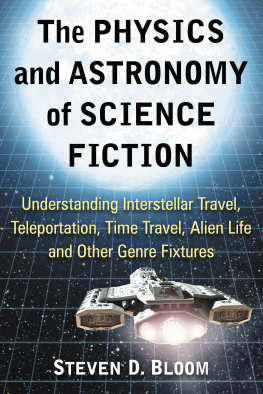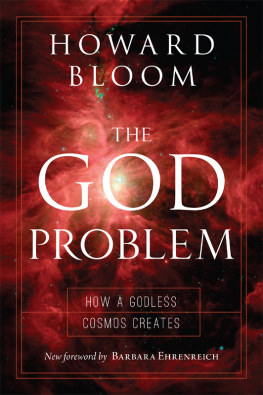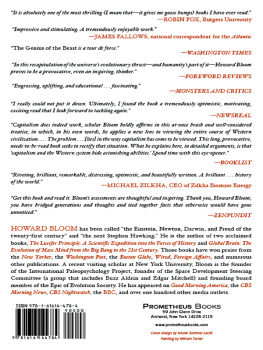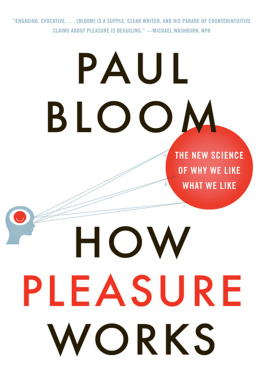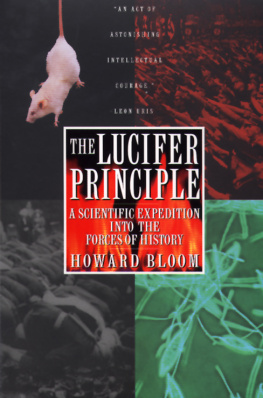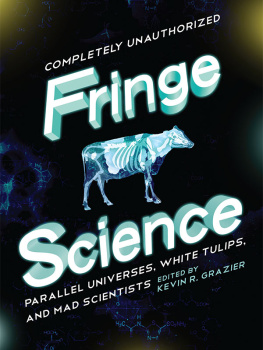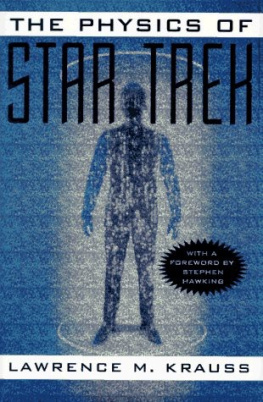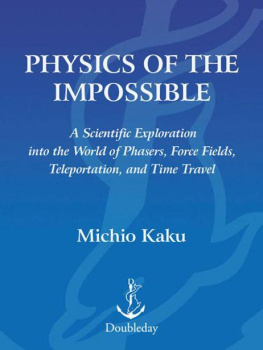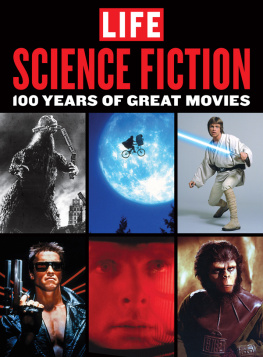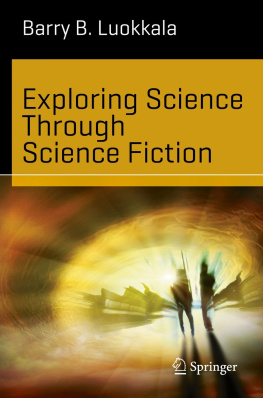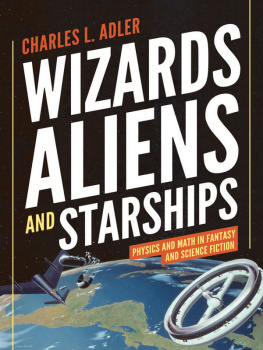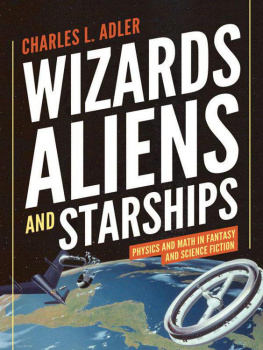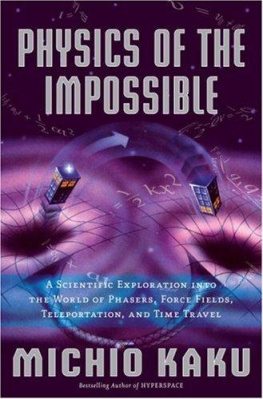
The Physics and Astronomy of Science Fiction
Understanding Interstellar Travel, Teleportation, Time Travel, Alien Life and Other Genre Fixtures
Steven D. Bloom

McFarland & Company, Inc., Publishers
Jefferson, North Carolina
LIBRARY OF CONGRESS CATALOGUING DATA ARE AVAILABLE
BRITISH LIBRARY CATALOGUING DATA ARE AVAILABLE
e-ISBN: 978-1-4766-2399-3
2016 Steven D. Bloom. All rights reserved
No part of this book may be reproduced or transmitted in any form or by any means, electronic or mechanical, including photocopying or recording, or by any information storage and retrieval system, without permission in writing from the publisher.
Front cover image 2016 Sylphe-7/iStock
McFarland & Company, Inc., Publishers
Box 611, Jefferson, North Carolina 28640
www.mcfarlandpub.com
To my wife, Jennifer,
and our daughter, Aviva,
with love
Preface
Science fiction films, television, books and short stories have been popular for decades and have, since their onset, relied on science and technology for their core concepts. With rocketing to the stars, time travel, planet busting weapons and sentient robots, its no wonder that they especially have relied on topics from physics and astronomy, and often from the cutting edge of these fields. Many fans have shown an interest in which concepts are possible (such as interstellar travel, time travel, teleportation or androids). In addition some fans have shown an interest in the basics, such as the background physics behind how a rocket works or how a star creates energy. Many books have been published on a select few of these topics (such as Michio Kakus Physics of the Impossible and Physics ofthe Future), but usually only have a couple of specific examples from science fiction (often just from Star Trek). Several more comprehensive books have been published on these topics over the years. One of these is over 30 years old and needed serious updating in both the physics and the popular cultural references (Amit Goswamis Cosmic Dancers). An excellent recent book, especially for those with a solid introductory physics and mathematics background is Charles Adlers Wizards, Aliens and Starships. His discussion of the physics of flight and space travel is particularly extensive. However, he is not reserved in placing equations (including calculus) directly in the main text, so this may be a difficult text for the more casual reader. Another very recent offering, Barry Luokallas Exploring Science through Science Fiction, is intended as a college textbook and is a little more general than what I have intended (touching on some other sciences, such as biology, which I only discuss minimally in this work).
So, where do I fit in to this picture? On July 20, 1969, on my fourth birthday, my parents unexpectedly placed my twin brother and me in front of our family television set, which at the time was a well-worn black and white model. Though, like many pre-school children, I didnt mind watching television, this was something other than what I was used to. We were watching a grainy transmission of something. I didnt quite understand what I was watching, but my mother did impart on me that this was a very important moment. I am sure that at the time I was more interested in birthday cake and what presents I had received (and, no doubt, being concerned that my brother didnt receive anything better than what I had gotten). However, I think a seed of an idea was definitely planted that day. It was shortly afterward that I began to read my older brothers copy of the Golden Book of Science. This book was filled with illustrations of bugs, plants, and even dinosaurs. However, I was most intrigued by the pictures of planets and galaxies. I began to understand at this time that astronomers were the people who spend their time observing these objects and drawing conclusions about them. I knew then that I wanted to be an astronomer.
From there, I went along the usual path for people interested in this field, studying a great deal of physics and mathematics, as well as astronomy, in high school, college and up to the point of receiving my Ph.D. in Astronomy in 1994. I was lucky to further work on my research during several post-doctoral appointments, but as excited as I was about some of my findings, especially during my time at NASAs Goddard Space Flight Center, I wanted to also spend some time teaching and directing students in research. Luckily, I was able to find my current job as a professor at Hampden-Sydney College. There I have been especially grateful to teach two interdisciplinary seminars, combining various topics with the physics of science fiction. The first of these was combined with philosophy and taught with Dr. Marc Hight and the second was combined with literature and taught with Dr. Steele Nowlin. Shortly after the first seminar concluded in 2003, I began to think about writing this book, but I did not think I had the time then to commit to it. I felt the same way after the second course was taught (coinciding with the birth of our daughter). Then after a visit by science fiction author and critic John Kenneth Muir to Hampden-Sydney I felt energized to begin this project.
I feel I need to say a little bit about what this book is meant to be. I hope to explain some complex topics that often appear in science fiction, while always referring to some of the examples from your favorite books, television, and film. If you are very familiar with physics and astronomy, you may be able to skip some of the first two chapters, or at least skim over the parts that are less familiar to you. It is certainly not meant to be an encyclopedia of science fiction, and not even a thorough listing of the science fiction that touches on the physics and astronomy mentioned in this book. It is also not meant to be a critical history of science fiction or any of the individual works touched upon, though I do make some critiques of my own throughout. So, though I hope I have presented many rich examples, I am sure I have inadvertently left out a number of excellent works. I also do not intend to pick apart your favorite movies or television shows. Every such television show or film was meant to be a creative and entertaining enterprise. In most cases, science was meant to take a back seat (at least in the end, no matter what the intentions) more or less from the beginning. I cannot fault writers and producers for that too much, since they can only create something that people will actually watch (or they will be unemployed), and sometimes that means making compromises.
In addition to the individuals already mentioned above, Id especially like to thank my wife Jennifer for her support and our daughter Aviva for her infectious laughter filling our home. I am indebted to my parents and my brothers (and their families) for supporting my interests from a young age. Lastly, Id like to thank all of my students, past and present, for helping me to understand how I can best explain complex topics.
Chapter 1
Introductory Physics
The discoveries in physics over the last millennium, and especially in the last 200 years or so make up a vast body of work, and certainly too much to cover in detail here; however, it is possible to give a sense of the some of the most important, critical themes of physics, as well as some of the most recent discoveries and their relevance to the rest of physics. Rather than give a crash course in all of physics, my intention is to bring up these important themes, and as I am going along, point to how they have been effectively used in science fiction.
Next page
